 |
A culinary journey in Egypt
Egyptian cuisine and some of its recipes date back 5000 years and archeologists have even revealed the use of food as a means of payment during ancient times. Of course, there have been some adjustments to the dishes over the years, mainly with the addition of ingredients and styles taken from other cultures (note the dropping of alcoholic drinks has also been a part of this change).
Egyptian cuisine depends heavily on legumes such as beans and lentils as well as vegetables and onions making a regular appearance in most dishes. Vegetarians normally have no problem getting by in Egypt since meat has traditionally been expensive and thus less common. Around the Egyptian coast you will find more fish in the meals.

The Egyptian Bread Aish also forms part of most of the meals. Did you know that Aish is the Egyptian word for bread and also means life. Also, if you find there is no cutlery, it is common to use your bread to "spoon" the food.

ish - Aish is the Egyptian traditional pocket bread similar to pita bread. It is made by mixing wheat flour, water and salt then baked.
Aish baladi - same as above but it uses whole wheat bread.
Baba Ghanoush - Made from grilled eggplant that is peeled then mashed and mixed with tahini (see below), lemon juice, salt, pepper, parsley, cumin and dressed with olive oil. This dip has a smoky flavor and is best served with pita bread.

Hummus bi Tahina - a dip made from chickpea and sesame. It is usually served with grilled or toasted bread. It can also be used as a spread or in a sandwich.
Tahini - sesame paste
Tehina - This dip is made from sesame tahini, mixed with lemon juice and garlic to make a dip or spread that is typically served with pita bread.

Bram rice
Rice made with milk which is stuffed with chicken liver.
Mahshi
Stuffed vegetables with rice - A healthy vegetarian meal made by stuffing vegetables such as cabbage leaves, tomatoes, green peppers, aubergines, and courgettes with rice seasoned with herbs and spices. This is then placed in a pot and topped with tomato sauce and lemon.
Hamam Mahshi
Stuffed pigeon with rice - This is similar to Mahshi, though is made by stuffing rice, wheat or herbs into pigeon then grilled or roasted it.
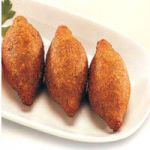
Kobeba
Fried balls of liver and spices
Falafel
Or ta'amiya - is a well-known dish in the Middle East thought to have originated in Egypt. It consists of balls of fava beans (broad beans) or chickpeas that have been deep fried.

Kofta - Sometimes called Kefta, these are spiced meatballs (looking more like small sausages than balls) often served on a skewer.
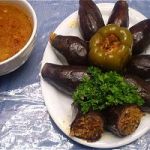
Hamam Mahshi - (stuffed pigeon) This is similar to Mahshi (see below), though is made by stuffing rice, wheat or herbs into pigeon then grilled or roasted it.
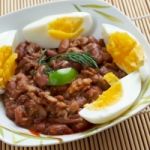
Also called Foul Mudammas in Arabic, foul is an Egyptian national dish and one of the most popular in the country. The locals particularly like it at breakfast time, sometimes with eggs. It is made with mashed boiled Fava beans (broad beans) served hot with oil, salt, and lemon juice. Traditionally eaten with pita bread. You can also add other ingredients such as tahini (sesame cream), and more...

Kibda - fried liver (beef) usually sold from a cart on the street.
Koshary - (Also known as Kushari) Considered one of the most famous dishes of Egypt, this vegetarian meal contains rice, spaghetti, macaroni, black lentils, chick peas, garlic, and is topped with a spicy tomato sauce (sometimes Chilli sauce) and fried onions. You will find Koshary being sold cheaply at street stalls and also in restaurants, some only specializing in this dish. So basically, you can't leave Egypt without trying this.
Macaroni béchamel - Penne pasta with a layer of cooked spiced meat and onions and white (Béchamel) sauce.
Molokhia (or Molokheyyah) - A soup made from finely chopped mallow leaves mixed with ground coriander and garlic. It is a staple part of Egyptian food though is normally only eaten at home.. Sometimes chicken, lamb or rabbit is added to this greenish soup.
Roz meammar - milk, butter or cream, chicken stock or broth add to rice that has already been cooked which is then all baked together in an oven.
Samak mashwy - fish that has been marinated and then grilled. Typical dish of Alexandria.
Shawarma - This popular Middle Eastern sandwich is made from shaved goat, chicken, lamb, beef, or turkey. It is rolled in pita bread and tahini sauce. This meal has its origin in Laventine cuisine and was incorporated into Egyptian cuisine.
Tehina salad - This salad is made by mixing sesame butter, chickpeas, vinegar, lemon juice, pepper, cumin, parsley, and olive oil.
Torly - Baked squash, potatoes, carrots, onions, and tomato sauce served on a tray to make a meal.

Tea is the favorite drink.

The karkadé is an infusion of hibiscus flowers.
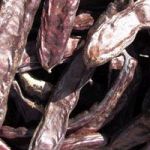
The raroub is a drink very popular during ramadan. It is made with dry caroub.
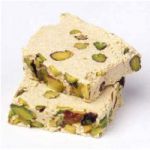
Baklava
Layers of flaky pastry filled with chopped nuts and honey syrup.
Bouzat haleeb
Egyptian ice-cream (though more like milk sherbet than cream)
Halawa (photo)
A popular confection in Egypt made from sesame paste. It is normally sold in blocks by weight.
Kishk
A cold yoghurt sauce.
Roz Be Laban
Rice pudding with a hint of vanilla
Umm Ali
Layers of bread soaked in milk with raisins and sometimes topped with nuts. It is served hot.
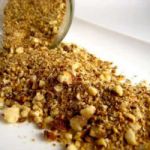
Dukkah is an Egyptian food commonly used as a dip and eaten along with Egyptian flatbread or raw vegetables, such as tomatoes or cucumber, as an hors d’oeuvre or side dish. It consists of a mixture of herbs, nuts and spices such as mint, salt, sesame, coriander and cumin. Dukkah is usually prepared at home and each family has a different twist to the recipe, but it is also sold at spice vendors in small paper cones. The name “Dukkah” is derived from the Arabic word “to pound” referring to how all the spices are pounded together to prepare the dish.

-

 Recipes
Recipes
-

 Products
Products
-

 Entertaining
Entertaining
-

 Chefs
Chefs
-

 Hints & Tips
Hints & Tips
-

 Glossaries
Glossaries








